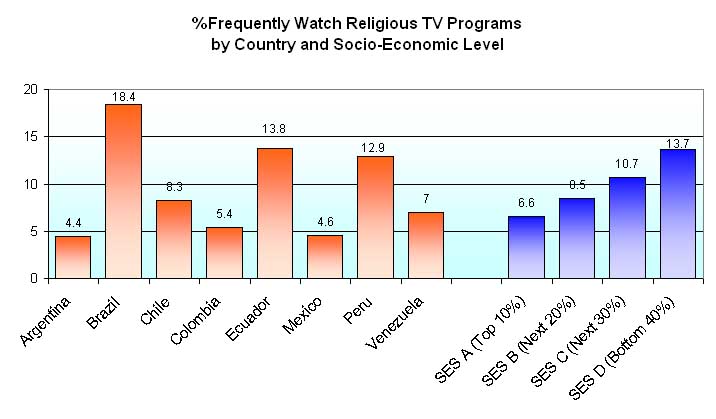
(source: 2003 TGI Latina)
Religious Television Programs in Latin America
Among television programs, religious programs hold a privileged position with respect to all other types of programs. To the extent that religious programs are shown on television, they are most often not commercial programs. That is to say, they are not media vehicles that are meant to carry paid television advertisements. As such, they must be based upon a radically different business model.
To the extent that religious programs appear on television, they are often produced and/or paid for by religious organizations. The purpose then is to proselytize and to instill and reinforce religious values. The program time is therefore more likely to be raised by donations from elsewhere, although sometimes the television program itself is a fund-raising exercise.
The metric of success for religious programs is different from commercial entities. Ratings are hardly the issue here. If the religious program is a fund-raising exercise, then the return on investment can be simply measured in terms of the amount of donations received. If the religious program attempts to proselytize, then the metric is harder to quantify because it is not known how to precisely count the number of lost souls who are thus saved from watching the program.
In any case, there are many fantastical stories about the success of religious programs. In the United States, Peter Horsfield wrote Religious Television: The American Experience to dispel many of the myths. In this article, we will make a broad overview of the reception of religious television programs in Latin America.
We will now cite some survey data from the 2003 TGI Latina study. This is a survey of 56,566 persons in eight Latin American countries. Within the TGI Latina study, 10.9% of the survey respondents said that they frequently watch religious television programs. The breakdowns by country and socio-economic level are shown in the following chart.
(source: 2003 TGI Latina)
Brazil is the country with the highest incidence. The next chart below looks first at breakdown by the socio-economic level of the 10,624 survey respondents within Brazil. This has the same pattern as the total Latin American trend -- the incidence decreases up the socio-economic scale. In the TGI Brasil study, respondents are also asked about their church affiliation. The breakdown of incidences by church affiliation is shown in this chart. While there are more Roman Catholics than any followers of other churches, the fact is that evangelical Christians are the ones who are more likely to watch religious television.
(source: 2003 TGI Brasil)
We can be more precise by looking at the television channels that were watched, as shown in the chart below. This is not a situation in which religious program viewers watch those programs to the exclusion of all other types of programs. Rather, religious program viewers seem to watch more of all other channels. In Brazil, Rede Vida is a religious channel. This is the channel with the highest viewing differential with respect to the total population.
(source: 2003 TGI Brasil)
(posted by Roland Soong on 2/17/2004)
(Return to Zona Latina's Home Page)